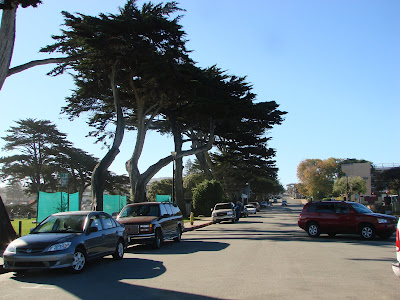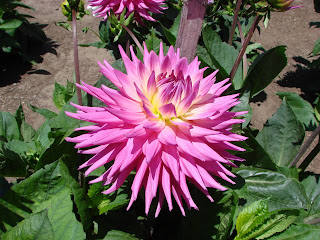The end of November, 2005, I received a brown box with the words “Jackson & Perkins” printed in on the outside. I opened the box with curiosity. Inside was a shiny red ceramic pot filled with 3 gigantic bulbs nestled in peat moss. Someone had sent us Amaryllis bulbs for the holidays. A note inside read, “And enjoy your living gift with the warm wishes of the thoughtful person whose name appears on the outer address label.” Upon further inspection I realized that my brother Wayne and his wife Phyllis had sent us this gift. Every year my family rotates names for Christmas, and that year my oldest brother Wayne and his wife Phyllis had my name. I was moved that they had found the time to send this plant, for Phyllis had just finished her last round of chemotherapy, and the treatments had been very difficult on her. (Back in June, 2005, she had also gone through a successful double mastectomy for breast cancer.)
This gift was also appreciated since I had purchased several Amaryllis bulbs as gifts for my friends. I planted them and gave them away just in time for them to bloom during the holidays. My two young children were upset that I had given the plants away before we were able to enjoy any of the flowers. I felt bad that I had not bought an Amaryllis for our family to keep.
So, here I was relishing taking the packing off the bulbs in the festive red pot. I placed the new gift in the bay window in our kitchen. Our family anxiously awaited the glorious blooms.
The plant did not disappoint us, and the oversized bulbs sprouted long green stalks which exploded into crimson trumpet-shaped flowers. Every time I looked at the plant it made me happy.

I didn’t receive a response to this e-mail. I was puzzled, since Phyllis had always been so good at corresponding. I soon found out the reason, Phyllis had not been feeling well since her chemotherapy ended in November, and health problems were beginning to emerge for which the doctors didn’t seem to have answers.
The beautiful blooms began to fade on the Amaryllis weeks after the Christmas decorations had been put away. I pulled out the directions that had come with the bulbs:
After-Bloom Care
After the Blooms have faded, cut the stalk off 1”- 2” above the bulb, being careful not to disturb the foliage. Continue watering and apply fertilizer occasionally, as you would for any potted plant. In the fall, discontinue watering and store the plant in a cool place (45 – 50 degree F). Approximately six weeks before blooms are desired, return your Amaryllis to room temperature and begin watering – lightly at first until growth is observed, then normally, to keep soil moist.
All of that seemed pretty complicated and life was busy with kids, their school, and numerous activities. So the once magnificent plant got stuck out on our back patio, neglected and un-watered. I had fleeting thoughts of planting the bulbs in the garden if I ever found the time.
Time passed by quickly at our house as the children’s school year drew to an end. During the past few months news of Phyllis’ health was like a rollercoaster ride. She is doing better. Now she is doing worse. Without reason, her health was declining. Details became painful to hear, as when Phyllis e-mailed us the following on March 9th, “They drained the right lung (her's) on Wednesday (2 liters fluid.)”
Intricate tests were run to find out why she wasn’t thriving. News of the test results came as fingernails scrapping a chalkboard—apparently the chemotherapy had done irreparable damage to her heart. Sadness crept in, as hope started slipping away. My brother Wayne e-mailed the following on June 9th:
“Phyllis is really tired of the pain, her inability to do anything, and the quality of life she has experienced this past year. She almost welcomed the thought that perhaps the pain and frustration may soon be over. Her spirits are high, and right now her major motivation is to get somewhere where bells and alarms do not ring, no one takes your blood sugar and blood pressure every hour, and you eat what you damn well want!”
Early Sunday morning, June 18th the painful rollercoaster ride came to an end. We received news that Phyllis had passed away peacefully the night before, surrounded by her husband and two of her daughters.
With a heavy heart we made the trip—flying from San Jose to Las Vegas, and then driving on to Hurricane, Utah for the funeral services. Traveling the long distance in the sweltering summer heat was hard for me, for I was dealing with pain from a recent ankle surgery and navigating around on crutches. But, this was a trip that I needed to make.
Saying goodbye to a loved one is hard. Phyllis’s service was a solemnly sad, yet wonderfully eloquent farewell. Memories of a “Getting to know you form” she had filled out and e-mailed me (on September 19, 2005) came to mind. When answering the form’s question, “If you could have any job what would it be?” Phyllis had written, “The Grandmother that I am.” Her funeral services given by her family proved she had successfully done the job she had set out to do in this life, and she had done it well!
Life marched on at a brisk pace for me–kids to take care of, appointments to keep, responsibilities to meet. Time can be cruel; it doesn’t slow down or pause when our bodies and minds ache for reprieve.

Just shortly after returning home I was sitting in the kitchen still trying to recover from the tole our trip had taken—feeling sorry for myself that my foot was still swollen, sore, and impossible to walk on —something caught my eye outside on our back patio. I rushed out to see . . . it was a new blossom beginning to emerge from the overgrown leaves of the abandoned Amaryllis. In disbelief I stared at the plant in the dusty red pot. My mind raced as I went back into the house to look up the instructions that had come with the bulbs. I pulled them out of my file and slowly read: “The Amaryllis is for indoor blooms on a yearly cycle. With proper care, the bulb will flower again each year.” This plant had bloomed just six months ago! How could it be blooming again, so soon—without any care?
Maybe this was just a coincidence, but I would like to think differently. I don’t know many people in my day-to-day life who would understand the significance of this bloom, but I do know someone in heaven that would. A small miracle seemed to have happened—one to brighten my day, remind me of a loved one, and tell me that my journey to Hurricane had not gone unnoticed. My thoughts drifted back to the short message that had come in the box with the Amaryllis, “And enjoy your living gift with the warm wishes of the thoughtful person whose name appears on the outer address label.”

Photo taken July 14, 2006
I feel part of the meaning of Christmas, and celebrating the birth of Christ, is to have hope. Hope that there is more to life than our crazy everyday existence, and hope that relationships and love reach past the bounds of this life. May you keep your loved ones close and enjoy each moment. Merry Christmas!

 Recently I was driving on the freeway, after doing something I had to do, and on my way to do something I needed to do. Blah, blah, blah. My life seemed so monotone and filled with have-to-dos. Driving south on the 101, I noticed a sign above the freeway that said "Los Angeles" (which is 6 ½ hours south of where we live). I knew Disneyland and carefree times were down that road. It took all my mental energy to make my responsible self take the next exit off the freeway—to my home—where my “Have-To-Do” list would continue. Even after taking the exit, I longed for that imaginary day at Disneyland—away from cares, worries, and responsibilities.
Recently I was driving on the freeway, after doing something I had to do, and on my way to do something I needed to do. Blah, blah, blah. My life seemed so monotone and filled with have-to-dos. Driving south on the 101, I noticed a sign above the freeway that said "Los Angeles" (which is 6 ½ hours south of where we live). I knew Disneyland and carefree times were down that road. It took all my mental energy to make my responsible self take the next exit off the freeway—to my home—where my “Have-To-Do” list would continue. Even after taking the exit, I longed for that imaginary day at Disneyland—away from cares, worries, and responsibilities.


 To put the size of the trees in perspective, my hubby is almost 6' 6" tall. The above 3 photos were taken at Lover's Point where we parked our car, then walked west along the coastal trail.
To put the size of the trees in perspective, my hubby is almost 6' 6" tall. The above 3 photos were taken at Lover's Point where we parked our car, then walked west along the coastal trail.








 Above: Remember those large
Above: Remember those large 











 Okay, I really should be posting about Halloween, or about seeing the beautiful migration of monarch butterflies we saw at Natural Bridges State Beach last weekend. But instead, I wanted to tack on a P.S. to my last entry regarding the San Francisco Conservatory of Flowers, since this post really is a part of that post. I didn’t include this with the last post, because I have too many photos I wanted to share! So here goes—
Okay, I really should be posting about Halloween, or about seeing the beautiful migration of monarch butterflies we saw at Natural Bridges State Beach last weekend. But instead, I wanted to tack on a P.S. to my last entry regarding the San Francisco Conservatory of Flowers, since this post really is a part of that post. I didn’t include this with the last post, because I have too many photos I wanted to share! So here goes—

























